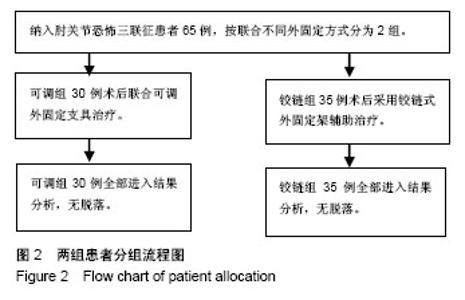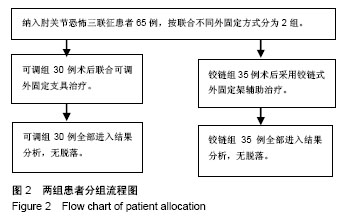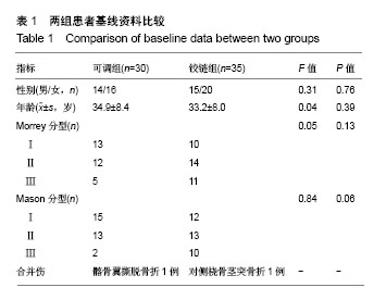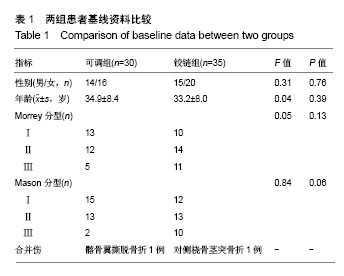Chinese Journal of Tissue Engineering Research ›› 2018, Vol. 22 ›› Issue (35): 5607-5613.doi: 10.3969/j.issn.2095-4344.1006
Previous Articles Next Articles
Efficacy of adjustable external support versus hinged external fixator in the treatment of terrible triad of elbow
Hu Panyong, Yang Shaoan, Cai Baota, Cao Jun, Yang Xiao
- Department of Traumatic Orthopedics, Zhujiang Hospital of Southern Medical University, Guangzhou 510280, Guangdong Province, China
-
Online:2018-12-18Published:2018-12-18 -
Contact:Yang Shaoan, Master’s supervisor, Chief physician, Associate professor, Department of Traumatic Orthopedics, Zhujiang Hospital of Southern Medical University, Guangzhou 510280, Guangdong Province, China -
About author:Hu Panyong, Master candidate, Physician, Department of Traumatic Orthopedics, Zhujiang Hospital of Southern Medical University, Guangzhou 510280, Guangdong Province, China -
Supported by:the Science Popularization Program of Guangzhou Haizhu District, No. 2014HZKP-TJ-12
CLC Number:
Cite this article
Hu Panyong, Yang Shaoan, Cai Baota, Cao Jun, Yang Xiao. Efficacy of adjustable external support versus hinged external fixator in the treatment of terrible triad of elbow [J]. Chinese Journal of Tissue Engineering Research, 2018, 22(35): 5607-5613.
share this article
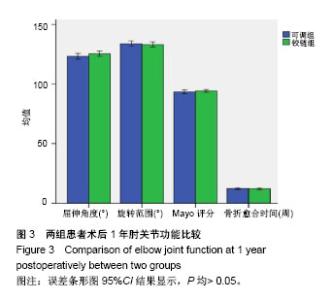
2.3 疗效分析评价 可调组肘关节屈伸活动度111°-137°,平均(123.3±6.4)°;前臂旋转范围124°-147°,平均(133.9±6.4)°;骨折愈合时间为9-18周,平均(12.3±1.9)周;Mayo评分优28例,良2例;2例出现肘关节异位骨化,1例肘关节外翻畸形愈合。铰链组肘关节屈伸活动度113°-142°,平均(125.5±6.4)°;前臂旋转范围120°-147°,平均(133.1±6.5)°;骨折愈合时间为9-18周,平均(12.0±1.9)周;Mayo评分优34例,良1例;1例外固定架旋转中心偏移,1例出现针道感染。2组术后在肘关节屈伸活动度、前臂旋转角度、骨折愈合时间及Mayo评分方面差异均无显著性意义(P > 0.05),见图3."
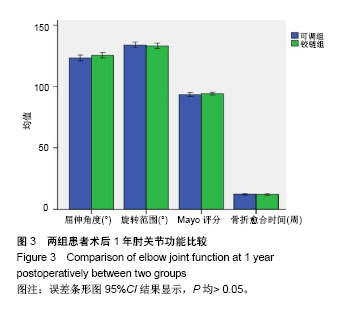
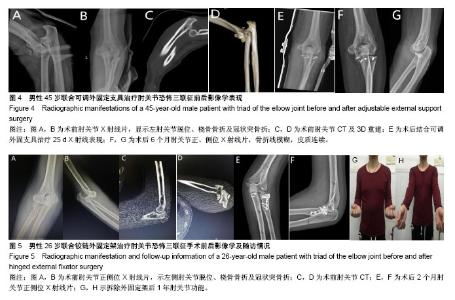
2.4 患者术后并发症 65例患者术前1例并髂骨翼撕脱骨折,1例合并对侧桡骨茎突骨折,保守治疗均恢复良好,对患者肘关节骨折康复过程均无影响。肘关节恐怖三联征术后,可调组2例发生肘关节周围异位骨化,1例出现肘关节外翻畸形愈合,并发症发生率10%;铰链组1例术后检查发现旋转中心偏移,1例发生外固定针道感染,并发症发生率为6%。 2.5 植入材料的不良反应 内植物中均无局部炎症反应、刺激反应、变态反应、组织增生;无材料腐蚀、磨损、生物降解、材料退化等。 2.6 典型病例分析 病例1:男性患者,45岁,2 m高处坠落致左肘关节疼痛、肿胀,X射线提示左肘关节桡骨头骨折、尺骨近端骨折合并肘关节后脱位,冠状突骨折Morrey分型Ⅰ型,桡骨头骨折Mason分型Ⅲ型。入院后第6天在臂丛麻醉下行左桡骨头骨折、冠状突骨折、肘关节脱位切开复位及侧副韧带修复术,联合可调外固定支具治疗,见图4。 病例2:男性患者,26岁,骑车摔倒致左肘关节疼痛、肿胀,X射线提示桡骨头骨折、尺骨近端骨折合并肘关节后脱位,冠状突骨折Morrey分型Ⅱ型,桡骨头骨折Mason分型Ⅲ型。入院后第4天在臂丛麻醉下行左桡骨头骨折、尺骨骨折、肘关节脱位切开复位及侧副韧带修复术,联合铰链外固定架治疗,见图5。"
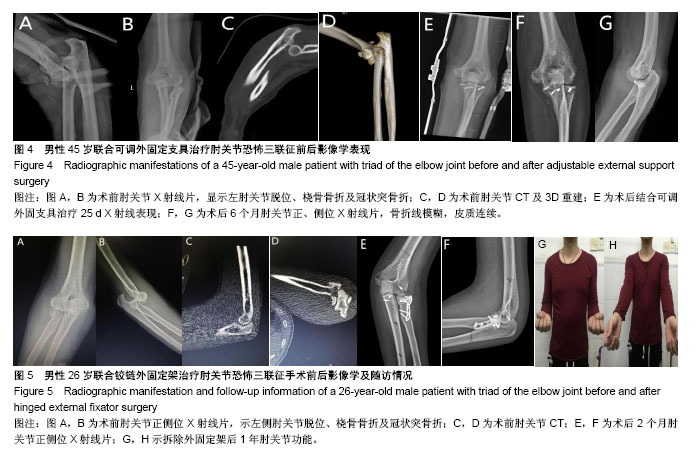
| [1] Hotchkiss RN. Fracture and dislocation of the elbow. 4th ed, Philadelphia: lippincott-Raven, 1996:929-1024. [2] Zeiders GJ, Patel MK. Management of unstable elbows following complex fracture dislocations the "terrible triad" injury. J Bone Joint Surg Am. 2008;90(4):75-84. [3] Ikemoto RY, Murachovsky J, Bueno RS, et al. Terrible triad of the elbow: functional results of surgical treatment. Acta Ortopedica Brasileira. 2017;25(6):283-286. [4] Najd Mazhar F, Jafari D, Mirzaei A. Evaluation of functional outcome after nonsurgical management of terrible triad injuries of the elbow. J Shoulder Elbow Surg. 2017;26(8): 1342-1347. [5] Adr J, Jordan RW. Complex Elbow Dislocations and the "Terrible Triad" Injury. Open Orthop J. 2017;11(Suppl-8, M7): 1394-1404. [6] O'Driscoll SW, Jupiter JB, King GJ, et al. The unstable elbow. J Bone Joint Surg Am. 2000;50(5):89-102. [7] Sakai K, Shirahama M, Shiba N, et al. Primary hinged external fixation of terrible triad injuries and olecranon fracture-dislocations of the elbow. Kurume Med J. 2017;63(1): 7-14. [8] 赵王林,杨海韵,吴征杰.金属铰链外固定支架与有限针钉置入内固定治疗肘关节“恐怖三联征”[J].中国组织工程研究, 2011, 15(17):3206-3211.[9] Zhou Y, Cai JY, Chen S, et al. Application of distal radius-positioned hinged external fixator in complete open release for severe elbow stiffness. J Shoulder Elbow Surg. 2017;26(2):e44-e51. [10] Zhang J, Tan M, Kwek EB. Outcomes of coronoid-first repair in terrible triad injuries of the elbow. J Arch Orthop Trauma Surg. 2017;(2):1-7. [11] Regan W, Morrey B. Fractures of the coronoid process of the ulna. J Bone Joint Surg Am. 1989;71(9):1348-1354. [12] Mason ML. Some observations on fractures of the head of the radius with a review of one hundred cases. J Br J Surg. 1954; 42(172):123-132. [13] Imatani J. lateral collateral ligament injury: treatment for acute cases. J Rinsho Seikei Geka. 2006;41:1267-1272. [14] Chen HW, Wang ZY, Wu X, et al. Evaluation of a combined posterior lateral and anteromedial approach in the treatment of terrible triad of the elbow: A retrospective study. J Med. 2017;96(22):e6819. [15] Zhang D, Tarabochia M, Janssen S, et al. Risk of subluxation or dislocation after operative treatment of terrible triad injuries. J Orthop Trauma. 2016;30(12):660. [16] Du JF, Zhu YY. Treatment of terrible triad of elbow with open reduction and internal fixation through antero medial approach combined with lateral approach. J Zhongguo Gu Shang. 2014;27(11):896-899. [17] Barnes LF, Lombardi J, Gardner TR, et al. Comparison of exposure in the kaplan versus the kocher approach in the treatment of radial head fractures. J Hand. 2018;(345): 155894471774566. [18] Chen HW, Wang ZY, Wu X, et al. Evaluation of a combined posterior lateral and anteromedial approach in the treatment of terrible triad of the elbow: A retrospective study. J Med. 2017;96(22):6819-6823. [19] Reichel LM, Milam GS, Reitman CA. Anterior approach for operative fixation of coronoid fractures in complex elbow instability. J Tech Hand Upper Ex Surg. 2012;16(2):98-104. [20] Wang Y, Pang GX, Zhang HB, et al. Surgical treatment for terrible triad of the elbow through medial and lateral approach. J Zhongguo Gu Shang. 2016:662-664. [21] Zhang D, Tarabochia M, Janssen S, et al. Risk of subluxation or dislocation after operative treatment of terrible triad injuries. J Orthop Trauma. 2016;30(12):660. [22] Bellato E, Kim Y, Fitzsimmons JS, et al. Coronoid reconstruction using osteochondral grafts: a biomechanical study. J Shoulder Elbow Surg. 2017;26(10):1794-1802. [23] Erhart S, Lutz M, Deml C, et al. Restoring independency with an osteochondral graft of the navicular for coronoid process reconstruction. J Arch Orthop Trauma Surg. 2017;137(2): 225-232. [24] Iannuzzi NP, Paez AG, Parks BG, et al. Fixation of regan-morrey typeⅡ coronoid fractures: a comparison of screws and suture lasso technique for resistance to displacemen. J Hand Surg. 2017;42(1):11-14. [25] Gonçalves LB, Neto AJ, Correa MF, et al. Terrible triad of the elbow: influence of radial head treatment. J Revista Brasileira De Ortopedia. 2014;49(4):328-333. [26] Yoshida M, Goto H, Takenaga T, et al. Anterior and posterior bands of the anterior bundle in the elbow ulnar collateral ligament: ultrasound anatomy. J Shoulder Elbow Surg. 2017; 26(10)::1803-1809. [27] Hatta T, Nobuta S, Aizawa T, et al. Comparative analysis of surgical options for medial collateral ligament repair in terrible triad injury of the elbow. J Orthop Rev. 2016;8(3):89-93. [28] Motisi M, Kurowicki J, Berglund DD, et al. Trends in management of radial head and olecranon fractures. J Open Orthop J. 2017;11(1):239-247. [29] Madey SM, Bottlang M, Steyers CM, et al. Hinged external fixation of the elbow: optimal axis alignment to minimize motion resistance. J Orthop Trauma. 2000;14(1):41. [30] Castelli A, D'Amico S, Combi A, et al. Hinged external fixation for Regan-Morrey type I and II fractures and fracture-dislocations. J Orthop Traumatol. 2016;17(2): 175-179. [31] Shukla DR, Golan E, Nasser P, et al. Importance of the posterior bundle of the medial ulnar collateral ligament. J Shoulder Elbow Surg. 2016;25(11):1868-1873. |
| [1] | Xu Feng, Kang Hui, Wei Tanjun, Xi Jintao. Biomechanical analysis of different fixation methods of pedicle screws for thoracolumbar fracture [J]. Chinese Journal of Tissue Engineering Research, 2021, 25(9): 1313-1317. |
| [2] | Jiang Yong, Luo Yi, Ding Yongli, Zhou Yong, Min Li, Tang Fan, Zhang Wenli, Duan Hong, Tu Chongqi. Von Mises stress on the influence of pelvic stability by precise sacral resection and clinical validation [J]. Chinese Journal of Tissue Engineering Research, 2021, 25(9): 1318-1323. |
| [3] | Zhang Tongtong, Wang Zhonghua, Wen Jie, Song Yuxin, Liu Lin. Application of three-dimensional printing model in surgical resection and reconstruction of cervical tumor [J]. Chinese Journal of Tissue Engineering Research, 2021, 25(9): 1335-1339. |
| [4] | Zhang Yu, Tian Shaoqi, Zeng Guobo, Hu Chuan. Risk factors for myocardial infarction following primary total joint arthroplasty [J]. Chinese Journal of Tissue Engineering Research, 2021, 25(9): 1340-1345. |
| [5] | Wei Wei, Li Jian, Huang Linhai, Lan Mindong, Lu Xianwei, Huang Shaodong. Factors affecting fall fear in the first movement of elderly patients after total knee or hip arthroplasty [J]. Chinese Journal of Tissue Engineering Research, 2021, 25(9): 1351-1355. |
| [6] | Wang Jinjun, Deng Zengfa, Liu Kang, He Zhiyong, Yu Xinping, Liang Jianji, Li Chen, Guo Zhouyang. Hemostatic effect and safety of intravenous drip of tranexamic acid combined with topical application of cocktail containing tranexamic acid in total knee arthroplasty [J]. Chinese Journal of Tissue Engineering Research, 2021, 25(9): 1356-1361. |
| [7] | Xiao Guoqing, Liu Xuanze, Yan Yuhao, Zhong Xihong. Influencing factors of knee flexion limitation after total knee arthroplasty with posterior stabilized prostheses [J]. Chinese Journal of Tissue Engineering Research, 2021, 25(9): 1362-1367. |
| [8] | Huang Zexiao, Yang Mei, Lin Shiwei, He Heyu. Correlation between the level of serum n-3 polyunsaturated fatty acids and quadriceps weakness in the early stage after total knee arthroplasty [J]. Chinese Journal of Tissue Engineering Research, 2021, 25(9): 1375-1380. |
| [9] | Zhang Chong, Liu Zhiang, Yao Shuaihui, Gao Junsheng, Jiang Yan, Zhang Lu. Safety and effectiveness of topical application of tranexamic acid to reduce drainage of elderly femoral neck fractures after total hip arthroplasty [J]. Chinese Journal of Tissue Engineering Research, 2021, 25(9): 1381-1386. |
| [10] | Wang Haiying, Lü Bing, Li Hui, Wang Shunyi. Posterior lumbar interbody fusion for degenerative lumbar spondylolisthesis: prediction of functional prognosis of patients based on spinopelvic parameters [J]. Chinese Journal of Tissue Engineering Research, 2021, 25(9): 1393-1397. |
| [11] | Lü Zhen, Bai Jinzhu. A prospective study on the application of staged lumbar motion chain rehabilitation based on McKenzie’s technique after lumbar percutaneous transforaminal endoscopic discectomy [J]. Chinese Journal of Tissue Engineering Research, 2021, 25(9): 1398-1403. |
| [12] | Chen Xinmin, Li Wenbiao, Xiong Kaikai, Xiong Xiaoyan, Zheng Liqin, Li Musheng, Zheng Yongze, Lin Ziling. Type A3.3 femoral intertrochanteric fracture with augmented proximal femoral nail anti-rotation in the elderly: finite element analysis of the optimal amount of bone cement [J]. Chinese Journal of Tissue Engineering Research, 2021, 25(9): 1404-1409. |
| [13] | Du Xiupeng, Yang Zhaohui. Effect of degree of initial deformity of impacted femoral neck fractures under 65 years of age on femoral neck shortening [J]. Chinese Journal of Tissue Engineering Research, 2021, 25(9): 1410-1416. |
| [14] | Zhang Shangpu, Ju Xiaodong, Song Hengyi, Dong Zhi, Wang Chen, Sun Guodong. Arthroscopic suture bridge technique with suture anchor in the treatment of acromioclavicular dislocation [J]. Chinese Journal of Tissue Engineering Research, 2021, 25(9): 1417-1422. |
| [15] | Liang Yan, Zhao Yongfei, Xu Shuai, Zhu Zhenqi, Wang Kaifeng, Liu Haiying, Mao Keya. Imaging evaluation of short-segment fixation and fusion for degenerative lumbar scoliosis assisted by highly selective nerve root block [J]. Chinese Journal of Tissue Engineering Research, 2021, 25(9): 1423-1427. |
| Viewed | ||||||
|
Full text |
|
|||||
|
Abstract |
|
|||||
